I’m doing science!
A while back, I was looking at my stack of autographed baseballs and noticed something strange. While Rob Carson’s signature was pristine, others that were obtained at the same time (about one year ago) in the same ink (blue Bic Round Stic) on the same balls (Rawlings Official League) had faded to some extent. Fading is a risk you take by displaying signed items, but since these are only items of sentimental value for me, I can live with some fading. This did get me thinking about something @METS_BRO said when I met him at Futures at Fenway last year about ink bleeding on synthetic leather baseball covers but not natural ones. I get all of my autographs on synthetic covers because, at $15.99 or more each, the real ones are just too expensive. An official synthetic cover ball and an Ultra Pro case only costs about $5, which is a bit more reasonable if you plan on getting more than a dozen autographs a year. While the original premise sounds interesting, I’m not about to throw away the money it would take to test it. I am wondering about how different inks react to synthetic cover baseballs, so it’s a good thing I set up this experiment two months ago.
People who know me might be surprised by this, but I only participated in a science fair once, way back in 4th grade. For my project, I built an electromagnet out of a lantern battery, a nail, and some wire and I nearly started a fire when I left it on overnight (but I got to it when it was only hot enough to melt plastic and smoke a little bit). After that experience, one point was made clear: demonstrations of scientific principles don’t win science fairs, data-driven experiments do. With that in mind, I sketched out an experiment to test the effects of different levels of light exposure on seed growth. While not nearly as fun as an electromagnet, it would give me a better chance of winning, which is what science fairs are all about. And then I forgot all about it until I needed a project for 9th grade Biology class. Even as a child, I mined my childhood for ideas rather than coming up with new ones.
What does this have to do with autographed baseballs? Well, I dusted off that project once again and replaced the seeds with baseballs. For the test subjects, three balls that had ink smudges on them were volunteered.
Test Scenario
Each ball included ink samples from two medium point Bic ball point pens (blue and black) and four Sharpie ultra fine point felt tip markers (blue, black, red, and green). These, along with some metallic markers, are what I typically carry with me to games. Once marked, the test subjects were sent their separate ways.
Test Ball #1: Placed on windowsill centered behind a window pane with an eastern facing and no obstructions blocking the sun until approximately noon.
Test Ball #2: Placed on same windowsill as Test Ball #1, one pane over, inside an Ultra Pro ball cube.
Test Ball #3: Placed inside a cardboard box and stored in a dark closet.
For comparison, “+2” was written in the corresponding ink to the right of the original markings two months after the test was initiated. Photographs were then taken to show the changes in ink color and contrast over this two month period.
Results
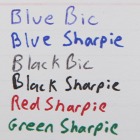 |
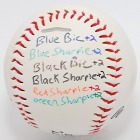 |
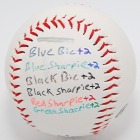 |
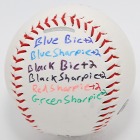 |
| Sample Card | Test Ball #1 | Test Ball #2 | Test Ball #3 |
If you think this writing looks bad, you should see my signature…
Effect of Ball Cube
From these results, it would appear that the ball cube provides a slight amount of UV protection in direct sunlight. And now that I look back over everything, it looks like I have two different models of Ultra Pro ball cubes in use, one that advertises UV protection and one that does not (this does not explain the Carson case, as none of the UV protected holders were in use there). The one used in this test does not advertise any UV protection, but the model that does advises against use in direct sunlight, so… Let’s call this one inconclusive. There is a clear difference in the fading of the red Sharpie between Test Ball #1 and Test Ball #2, with the marking on the unprotected ball turning bright orange. Fading of the other Sharpies appears to be slightly decreased, though it is not clear whether the fading has been stopped or only slowed down. We’ll need to revisit this.
Effect of Chemistry + Time
The control ball shows little change in the blue Bic or black Sharpie over the two-month test period. The red Sharpie has faded about as much as it did on Test Ball #2, indicating that UV exposure is not the cause of that particular fading (a point made more interesting by the severe fading seen in the unprotected Test Ball #1). The blue and green Sharpies have both faded, but not as severely as on either of the UV-exposed balls. Most interesting here is the black Bic, which shows both fading and bleeding after two months of darkness, compared with little of either for its blue counterpart.
Effect of UV Exposure
Combining the two results fairly conclusively shows that ink and sunlight don’t mix. All six of the inks tested show significant damage, though that isn’t unexpected. What is interesting though is how little of the fading can be attributed to UV exposure in the case of the red Sharpie. In fact, UV exposure only seems to affect the color, shifting it from faded red to faded orange.
Conclusions
First, it seems clear that red Sharpies are not the way to go on synthetic cover balls. UV or no UV, they just don’t last. Blue and green fare somewhat better, but exposure to sunlight will fade them into the same light teal. Black holds up the best of the Sharpies, but that isn’t saying much. Ball points seem to be the way to go, but not the black one I tested. Even without sunlight, it didn’t hold up well. Making a consistent mark was a problem for both ball points on the uneven surface of the ball, though the black was especially poor. I have to wonder if a fine point or gel ink would work better. In any case, blue ball point is clearly the way to go.
Recommendations
We’ve concluded that blue ball points are the best pens for the job, but there are many different types to choose from (though you could say that about all of the other options as well I suppose, but let’s try to keep this simple). Medium vs. fine, gel vs. not-gel, Bic vs. Pilot vs. Zebra vs. Uni-Ball vs… You get the idea. The next round of tests will need to account for at least a few of these, with the goal of finding a pen that writes smoothly and retains as much of its color and contrast as possible. I should probably also work in an Ultra Pro ball cube that advertises UV protection, so that means we’ll need another ball to throw into the mix. Tune in next time when we’ll be looking at four blue-ink balls. Until then, science!
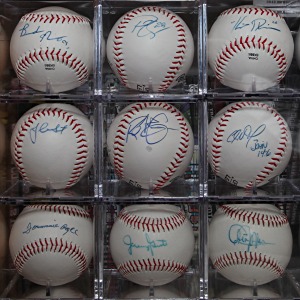
Comments are closed.